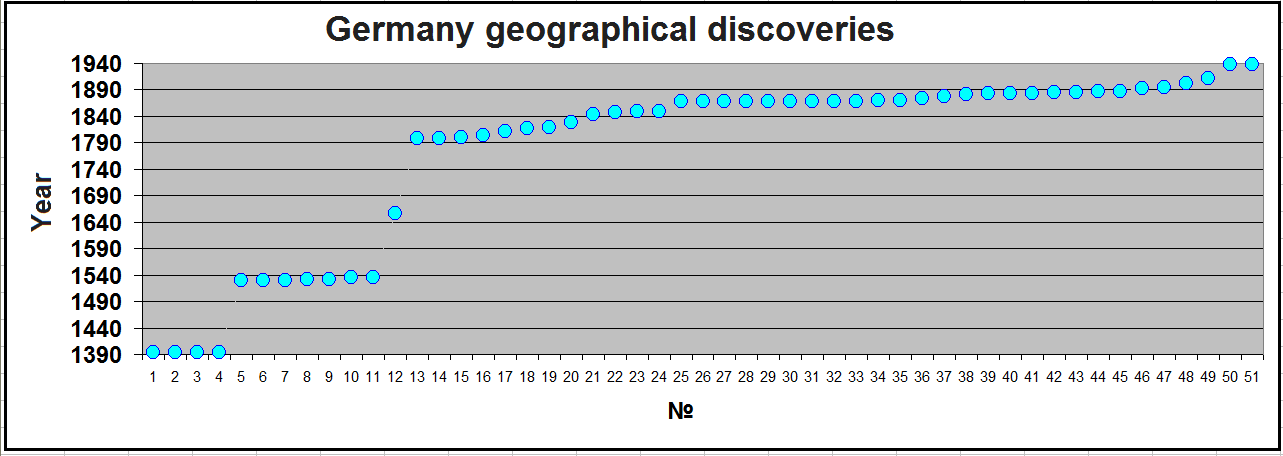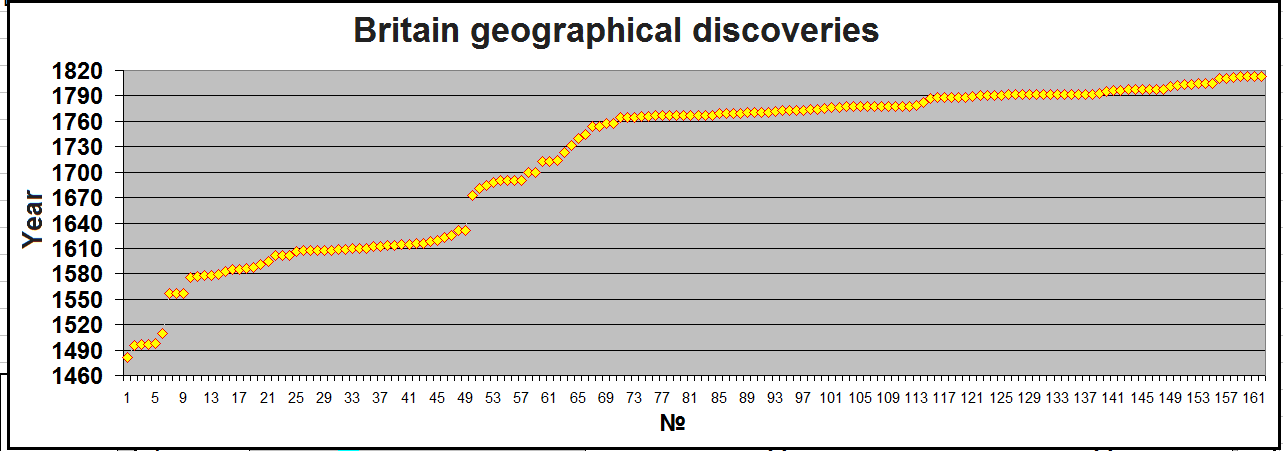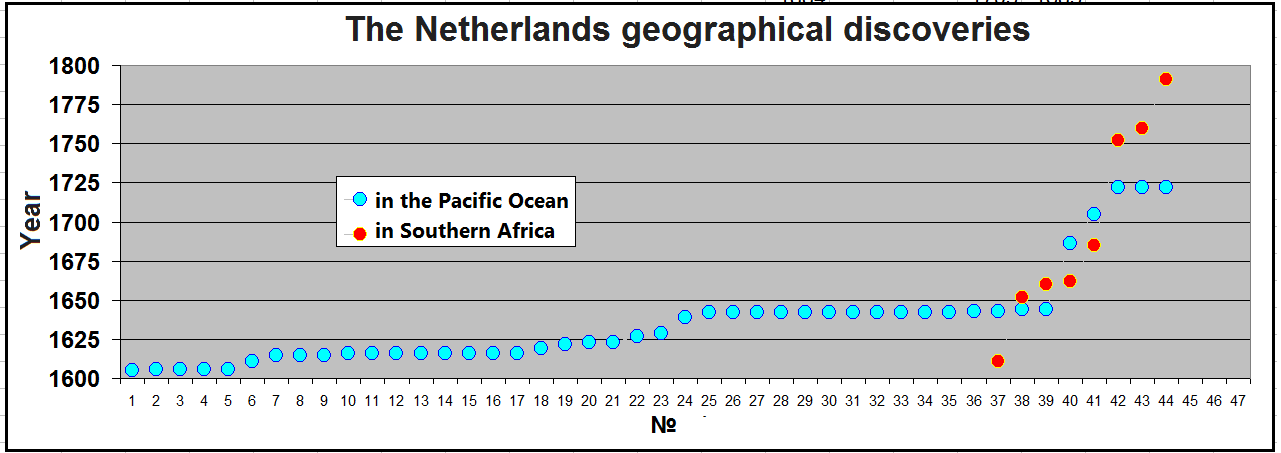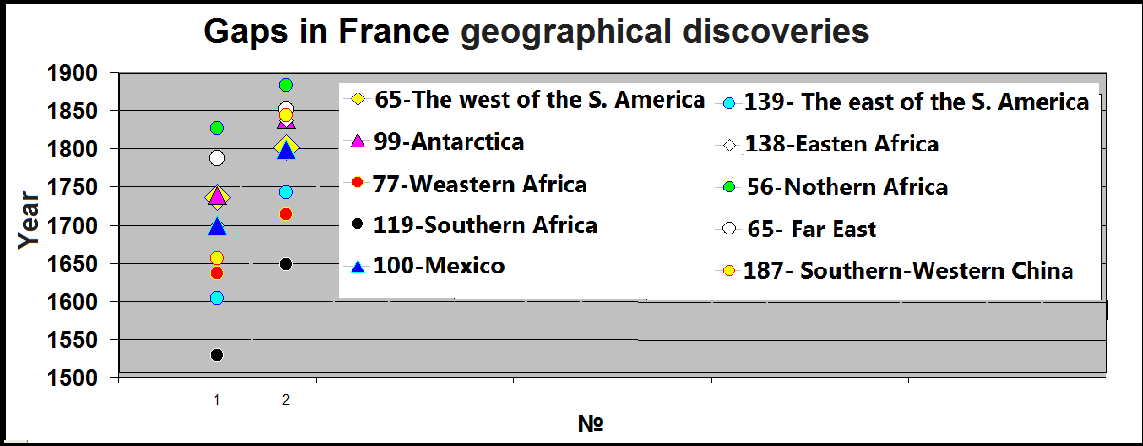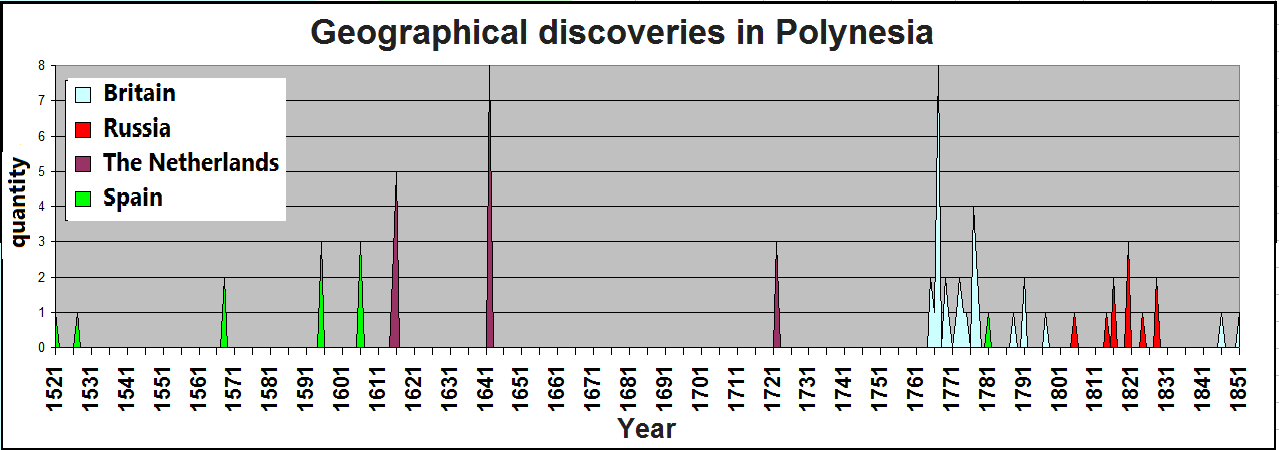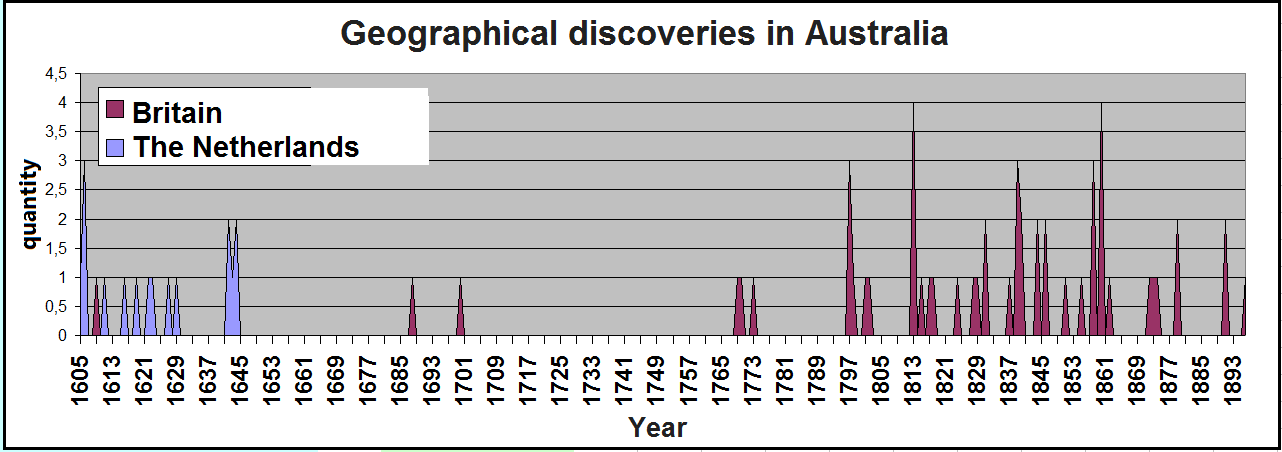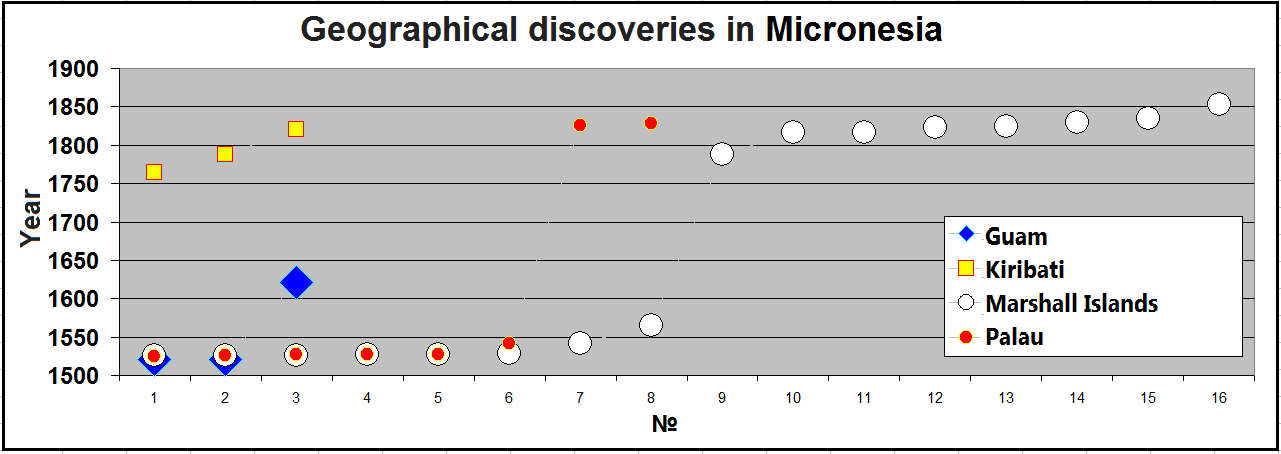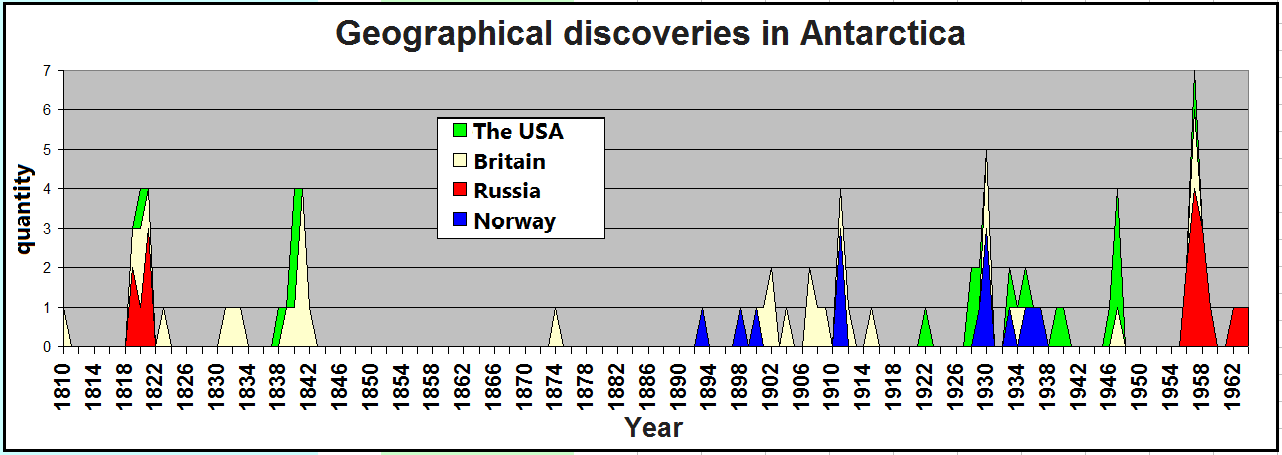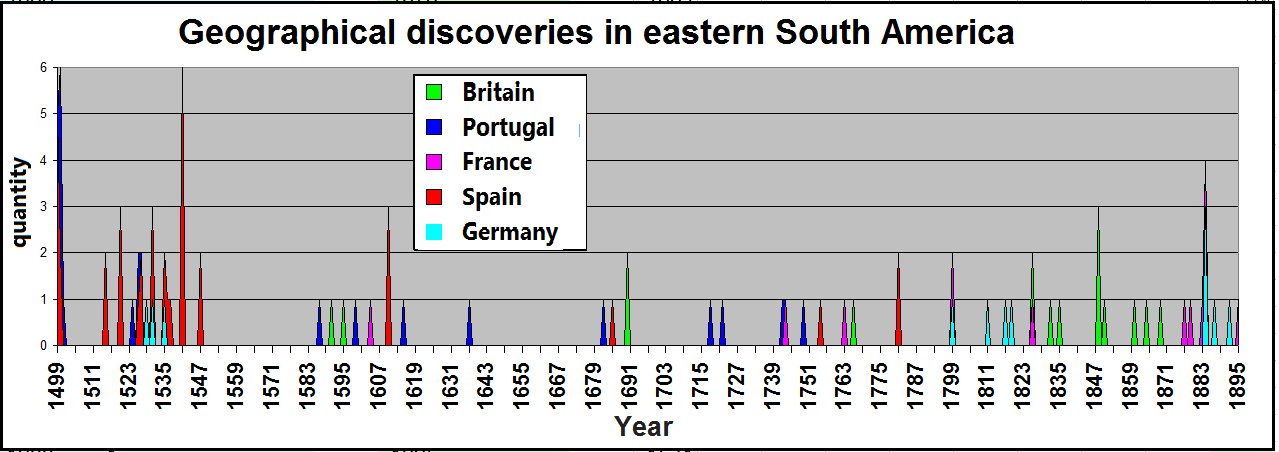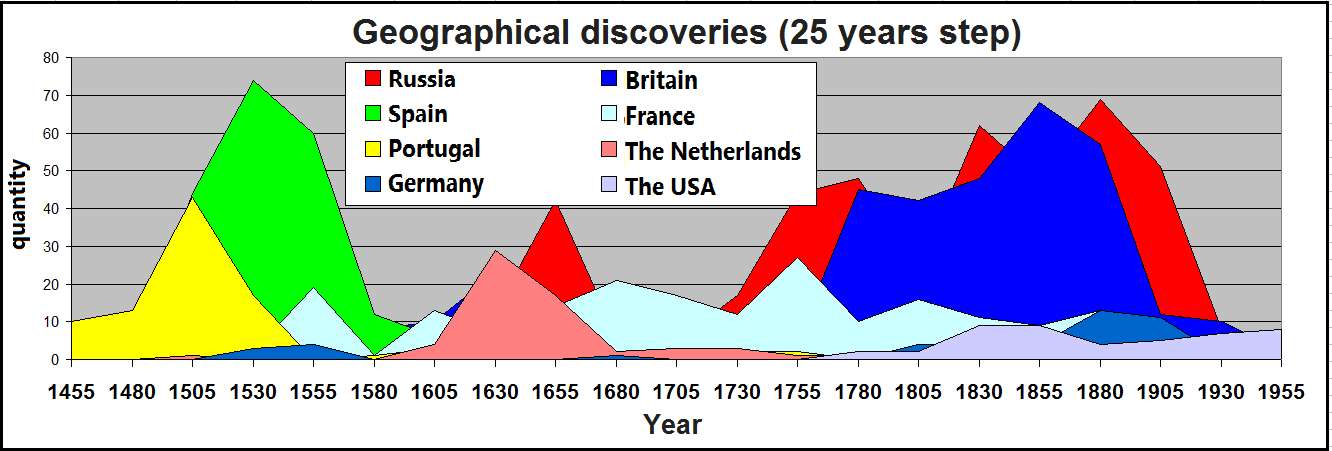The table used for estimation was created by the authors of Big Soviet Encyclopedia D.M. Lebedev, I.P. Magidovich and Y.M. Svet. These were 1044 dated evidences. 476 more evidences were collected while the research was being written. In total, there are finally 1470.
German travellers investigated the world in three series with gap between the series is about 150 and 250 years.
And here are Britain geographical discoveries. The gap is insignificant — 30 years, however dynamics of discoveries changes considerably:
— In 1576-1631 0.73 discoveries in a year were made;
— In 1632-1764 0,16 discoveries in a year took place;
— In 1765-1820 1,90 discoveries in a year happened.
The middle 132-year-old period of reduction of density of events in 5-12 times has no explanation.
And these are Spain discoveries in several macro-regions. Total gap is 125-250 years. Therefore, Spain makes the whole series of discoveries in the south of the today USA until 1541, then there is a pause in 250 years and in 1792 – we see again discoveries in the same region.
In addition, here we see the Netherlands discoveries. The ships reach Australia, and during 50 years make the whole series of discoveries in the Pacific Ocean, and only then Dutches suddenly think better of it, and start to settle their bases in Southern Africa. And after all, to found transitional bases for repair and potable water supply is № 1 condition.
In France discoveries, we present only the very first gap. The quantity of entirely empty years is specified in a legend. France penetrates into a region, there and then forgets about the reached success for 56-187 years, and only after these 56-187 years iterates discoveries in this region. And this is not all; there are often 2-3similar gaps on a line.
It is very important that this gap is located in different historical epochs, that is, interruption of researches by France cannot be simply explained by its intrinsic problems.
This chronological problem is inherent not only to pioneers, but also to the discovered terra: huge parts of continents for decades remain without research — each macro-region in its time.
The same problem is peculiar for smaller regions. In a case with islands in Polynesia we can see almost overall gap in the period of 1650-1750.
It is possible to show this gap on the example of pioneers — in Polynesia, as well. In 1643-1764 the region is occupied only by the Netherlands, and that is, in fact, a single short-term event – as a series of discoveries of 1722. In the situation when powers compete in speed to occupy new territories, almost total 121 year gap needs explanations.
The same situation is in Australia.
The similarsituation we see in Indonesia and Melanesia: there are 150 year gaps.
The same situation is in Micronesia: we see 200-250 years gaps.
In Antarctica, the gap is shorter, but the phenomenon, in fact, is the same.
Five powers are definitely interested in the eastern part of the South America, and thus — total gaps in discoveries are almost 50 years.
Here is a list of 100 regions having at least one gap in geographical discoveries lasting more than 99 years. Some gaps are easy to explain: so, expeditions could reach some places in the mountains of Khakassia for the first time only by 1883. However, more often the gap is around gulfs and straits, islands and peninsulas, that is, these objects are too remarkable not to notice them during 100-400 years.
Difference First Second Region
396 1493 1889 Vietnam
382 1511 1893 Kalimantan (Borneo)
381 1512 1893 Sulawesi and Sangihe islands
370 1500 1870 Malaysia
352 1516 1868 Guangdong (Canton)
350 1498 1848 Kenya
341 1517 1858 Uganda
324 1498 1822 Libya
322 1498 1820 Bengal
304 1549 1853 Colombia
297 1535 1832 Galapagos Islands
289 1570 1859 Mozambique
288 1581 1869 Colorado (CO)
284 1542 1826 Palau (Caroline Islands)
283 1600 1883 Republic of Khakassia
282 1511 1793 Sudan
267 1529 1796 South Korea
264 1535 1799 Venezuela
255 1609 1864 Democratic Republic of Congo (Zaire)
251 1627 1878 Indonesia
245 1527 1772 Hawaii (HI)
242 1616 1858 Malawi
234 1616 1850 Egypt
231 1604 1835 Guiana
225 1506 1731 Saint Helena, Ascension and Tristan da Cunha islands
223 1565 1788 Marshall Islands
220 1568 1788 Tuvalu
217 1648 1865 Madagascar
216 1616 1832 Chile
216 1654 1870 Mongolia
216 1614 1830 Nepal
216 1610 1826 Paraguay
214 1562 1776 Utah (UT)
205 1688 1893 Karachai-Cherkess Republic
202 1627 1829 Myanmar (Burma)
199 1649 1848 Amur Region
199 1568 1767 Solomon Islands
196 1624 1820 Punjab
195 1541 1736 Ecuador
193 1633 1826 Altai Territory
192 1494 1686 Japan
189 1637 1826 Peru
183 1557 1740 Uzbekistan
183 1609 1792 Georgia (GA)
179 1539 1718 Louisiana (LA)
178 1595 1773 Cook Islands
176 1557 1733 Russia
174 1604 1778 Saint Pierre and Miquelon
169 1515 1684 Bermudas
165 1639 1804 Honshu
162 1535 1697 California and Sonora
161 1643 1804 Hokkaido
158 1541 1699 Mexico
150 1616 1766 Wallis and Futunna Islands
149 1642 1791 Tasmania
148 1500 1648 Madagascar
147 1671 1818 Newfoundland and Labrador
145 1643 1788 Fiji
139 1616 1755 Argentina
138 1603 1741 California (CA)
137 1493 1630 Antilles
136 1722 1858 Sinkiang Uighur Region
135 1508 1643 Christmas Island
135 1599 1734 Arkhangelsk Region
135 1642 1777 Tonga
134 1600 1734 Yamalo-Nenetskiy Avtonomnyy Okrug
134 1604 1738 Nebraska (NE)
133 1513 1646 Chukchi Autonomous Okrug
130 1543 1673 Arkansas (AR)
129 1496 1625 England
127 1660 1787 Angola
127 1726 1853 Astrakhan Region
127 1716 1843 Tibet
127 1500 1627 Indonesia
127 1642 1769 New Zealand
125 1636 1761 India
124 1742 1866 Krasnoyarsk Region
124 1613 1737 Spitsbergen and Jan Mayen islands
123 1631 1754 East Canada
121 1518 1639 Amur Region
120 1686 1806 Arkansas (AR)
119 1497 1616 Wallis and Futunna Islands
116 1543 1659 Mississipi (MS)
115 1620 1735 Taimyr (Dolgan-Nenets) Autonomous Area
115 1524 1639 Honshu
114 1620 1734 Irkutsk Region
114 1497 1611 Republic of South Africa
110 1686 1796 Japan
109 1772 1881 Thailand
109 1669 1778 Oregon (OR)
106 1628 1734 Krasnoyarsk Region
106 1616 1722 French Polynesia
106 1503 1609 Seychelles
106 1616 1722 Samoa
106 1542 1648 Alaska (AK)
105 1618 1723 Gambia
104 1714 1818 Senegal
103 1739 1842 Taimyr (Dolgan-Nenets) Autonomous Area
100 1521 1621 Guam
100 1613 1713 Nova Scotia (Acadia)
Even a 30-year-old gap is a serious historical problem, and there are a lot of them (about 250), and it is almost one third of the total number of regions.
EXPLAINABLE FACTS
There is only one graph, which meaning we will try to explain. Here it is in a full form, and we will repeat it below, but in 25 year blocks — so it will be more understandable.
Now — 25 year blocks. We see activity of Spain and Portugal, then their inexplicable disappearance, and the Netherlands and France temporary take the place of these two countries, and in the end — steep rise of the discoveries made by Britain and Russia. And here we already see the sense.
At the first stage, Spain and Portugal discovered almost exclusively oceanic waterways and founded rare fortresses on river ways. The invasion purpose: to become mediators in trade between Europe and local authorities. They did not penetrate deep into the land; it happened at the second stage of discoveries via monastic orders, which de facto did not obey the royalty. It was a different type of colonization; their purpose was to coalescence with local authorities on the acceptance of Christianity by the last ones. At this particular time Spain and Portugal, for some unknown reason, were replaced by France and the Netherlands.
But time passed by, and the liquidation of the order of Jesuits started the third stage and the third type of colonization — Russian-British. These two countries almost had no problem of foundation of new cities-ports. They definitely did not put the task of total Christianization of the local population. Russia and Britain invaded in the depth of continents, — there where monks did not dare to pass.
This problem was extremely costly: Russia moved through Siberia across the flow of the rivers, and Britain reached the central areas of Africa and Australia, and, at all of them achieved their goals. Thus, it is clear that it was too early to put such problem at first two stages: the previous superstates had neither the necessary volume of resources, nor effective technologies.
THE PROBLEM FORMULATION:
The clearness presented above is categorically insufficient for understanding of the basic problem of geographical discoveries chronology. We will specify its characteristics:
1. Chronological gaps in the series of geographical discoveries is 30-250 years that excludes their natural character.
2. Chronological gaps are inherent both to the pioneers, and the objects of their discoveries: during the most different time the most different powers stop their research of different macro-regions.
3. Even if we do not see obvious gaps, there is constantly a long-term decrease of intensity of geographical discoveries.
4. Seafarers of different countries make comparable in complexity voyages with gaps in hundreds years, and the historical substantiation of this paradox does not basically exist.
The situation could be explained by struggle for diplomatic priorities and mass redating of the historical documentation when the priority in geographical discoveries was necessary for the state.
INDIRECT INSTRUCTIONS
ABOUT ROUND-THE-WORLD TRAVELS
There were three significant series of round-the-world travels: the very first one — in 1519-1522, then a series in 1766-1787, and the last series — 1819-1826. The gap between the first two series is 250 years, and between the last two — 40 years. Moreover, even if we use all this data, and not just the basic ones, we can see two very large gaps: 1522-1577 (55 years) and 1621-1766 (145 years).
1519-1522 the around-the-world cruise of a Portuguese FHernan Magellan
1577-1580 the second round-the-world travel of an Englishman Francis Drake
1586-1588 the third round-the-world travel of an Englishman Thomas Cavendish
1598-1601 Olivier van Noort — the first Dutch who went on the around-the-world cruise
1621 the first round-the-world expedition (unclear information)
1766-1768 the around-the-world cruise of an Englishman Samuel Wallis
1768 the first French round-the-world expedition (Louis Antoine de Bougainville).
1770-1778 Three round-the-world expeditions of an Englishman James Cook
1787 the first round-the-world travel of the USA ship
1787 the round-the-world expedition of La Perouse
1803 the first Russian round-the-world travel, I.F. Krusenstern and Y.F. Lisyansky
1819-1821 round-the-world expedition, F. Bellingshausen and M. Lazarev
1823-1826 Russian round-the-world expedition, Otto Evstafevich Kotzebue
1826 Dumont d’Urville
1826 the first military ship USS Vincennes left New York
1826-1829 Russian round-the-world expedition (Feodor Petrovich Lütke)
1831 the round-the-world expedition of the ship «Beagle» under Robert FitzRoy’s command
We are aware of the fact that the possibility of around-the-world cruise is connected, first of all, with the level of technologies, and this level in Europe was always approximately identical, such gaps between round-the-world travels of the comparable in their power countries seems impossible.
250 YEARS — IN CRUISES TO YEMEN, ORMUZ, INDIA
Around-the-world cruise de Elcano (1522) exists in the history not isolated; it occurred simultaneously with Hernan Cortes’s cruise to Mexico (1519) and Afonso de Albuquerque (1507-1515) — to Ormuz. All three captains had similar vessels and similar arming, and they all lived in one epoch. However, they were contemporaries not only to each other, but also, for example, to a Dane K. Niebuhr who appeared in the history with «lateness» for 250 years.
The matter is that Dane Karsten Niebuhr was the first person in Europe, who described Yemen in expeditions of 1761-1767, and it seems impossible to go to Ormuz (as the Portuguese did) for 250 years and to know nothing about Yemen all this long period. In fact, Ormuz is Yemen. It means that Albuquerque and Niebuhr, the first of Europeans who saw Yemen, were contemporaries.
What makes it even worse is that Karsten Niebuhr was mentioned in two Arabian expeditions – in 1706 and 1761-1767, and, in both cases, he was the only one survived. Thus, Karsten Niebuhr’s biography of was written by his son Barthold Georg Niebuhr, and his own biography regularly coincides with the biography of the father.
248 YEARS — IN CONQUEST OF MEXICO AND CALIFORNIA
The same difference of about 250 years is visible in destinies of Fray Junipero Serra, Moctezuma and Hernan Cortes. In the history, bringing these three people together, the most important person is Fray Junipero Serra living, at least, in two epoch. The dates are official.
1769 Fray Junipero Serra founded mission in California.
1697 Fray Junipero Serra was given by emperor Moctezuma the permission to christen the Californian Indians.
1521 Hernan Cortes conquered Mexico and killed the emperor Moctezuma
It is all — uniform process, and a difference between extreme dates of 248 years.
249-251 YEAR — IN FALL OF ORAN (ALGERIA)
In October, 1541 the European fleet, which had come to take the city of Oran in Algeria, was destroyed by the natural hazard. In this campaign Hernan Cortes died.
In 1790 and 1792, both times on 8 October, the European fleet, which had come to take the city of Oran in Algeria, was destroyed by the natural hazard.
In this block of the repeated events, we again see Hernan Cortes, factually bound to the same repeate figures — the Mexican emperor Moctezuma, Fray Hunipero Serra and the Dane Niebuhr. It is not a pure accident; these situations when authentically the same person appears in documents, dated with the gap of 50-250 years, have regular character. Though usually such fact are explained due to people’s longevity.
the Most vivid example is Clémence Isaure. On 3 May 1324 the first in the history tournament of knights-poets took place in Toulouse. It was named “Flower games” (Jeux floraux) and founded by the maiden by name of Clémence Isaure (Fr. Clemence Isaure, Ox. Clemenca Issaura). Three winners of the tournament received on a silver flower with gilding — a rose, a violet and a marigold. However, the archives give the birth date of Clémence Isaure as 1450 A.D. That was 126 years after the opening of the Flower Games. And it was not a different woman, her father’s name was Lucius too, she was rich as well, and she lived in the same palace and awarded poets with the same flowers at the same tournament.
And 115 years after her rebirth, in 1565 the maiden was visited by Catherine de’ Medici with the son Charles IX. Definitely, Isaure presented the honoured guests the same mentioned three flowers and she was still pretty, and her father’s name was Lucius. Thus, the cemetery mausoleum for Clémence Isaure was built in 1601, that is one hundred years later one of her official death date (1501). Moreover, there are data that 12 years before one more of her death dates (1488) a gravestone epitaph had already been compounded. If to collect all data concerning her in one table, we will have, at least, three lives lived by this lady. And if to consider that the epitaph was written immediately after her death (instead of a period of many years) the number of Clémence Isaure’s lives can easily rises to six.
All this leapfrog with dates has become known only because the municipality got interested in the property of Clémence’s inheritors, and the court got out those documents, which can be found in the archives. So here we have some historical discomfiture.
CONCLUSION
In the case with geographical discoveries, we deal with scale redating of enormous amount of the historical documentation. These event clusters are reorganized in the past in the whole amount, but it is impossible to solve the problem of similar complexity without any traces left. So the events still have duplicates, dated is correctly.
The theme “Chronology of the colonial goods” is closely connected with this research.
25 May, 2019 <https://scan1707.blogspot.com/2019/05/blog-post_25.html>
